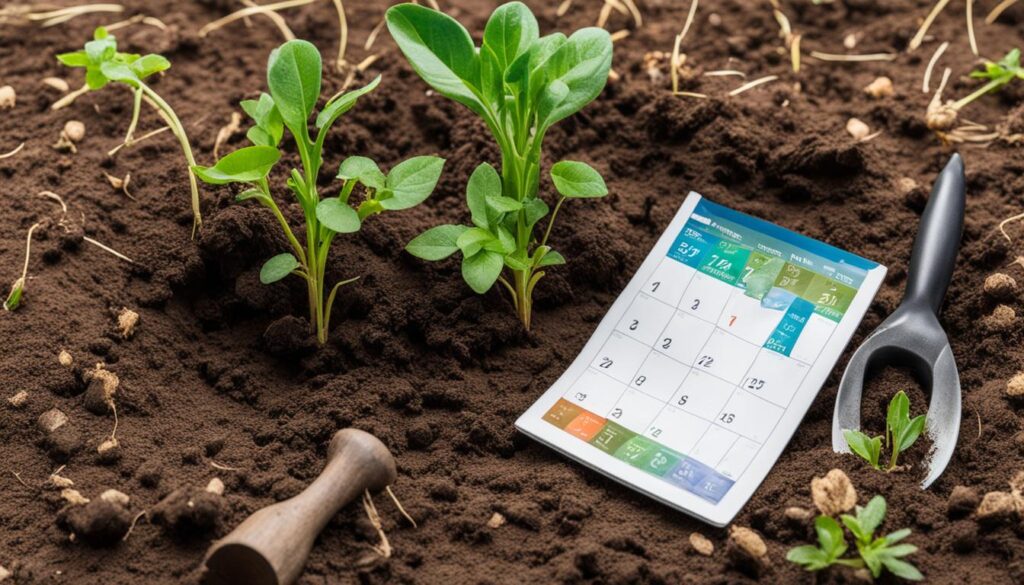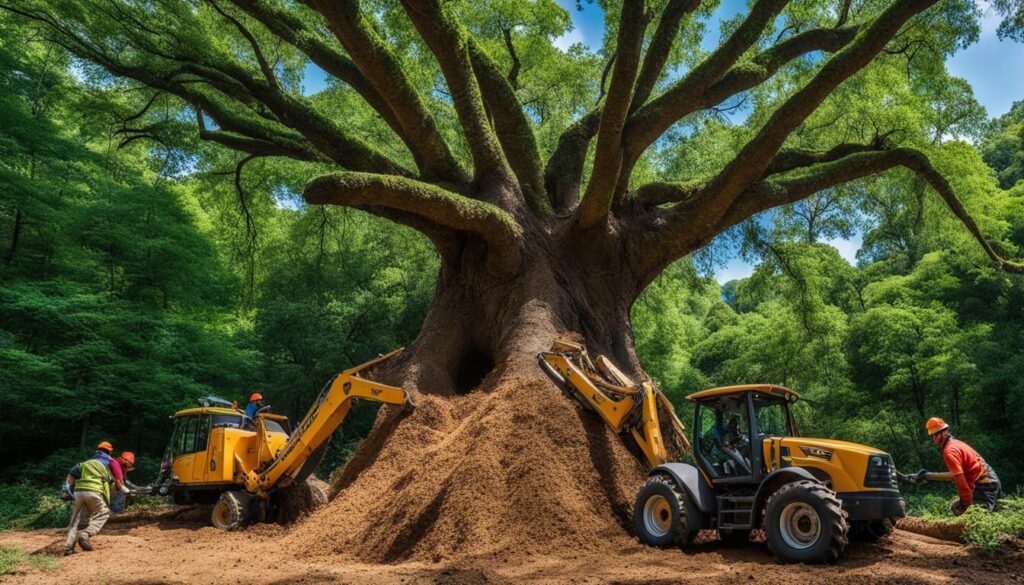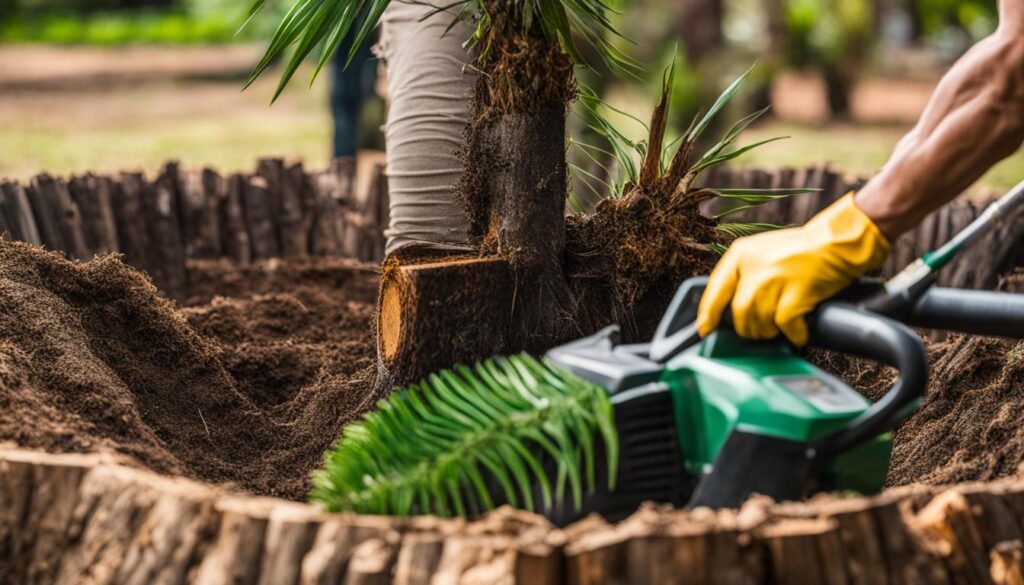As an avid gardener and environmental enthusiast, I recognize that patience plays a crucial role in the process of re-establishing a vibrant and healthy garden. One question that often arises amongst my fellow green-thumbed peers is about the timeline for planting after stump grinding, and more specifically, how soon after stump grinding can you plant? This curiosity is well-founded, as understanding the interplay between stump grinding and planting is fundamental to the successful introduction of a new tree into your space.
In my experience, I’ve learned that rushing to plant a new tree where a stump was just removed may not always yield the best results. Just as an artist prepares a canvas before painting, we must prepare the ground after stump grinding, which involves acknowledging that remnants and roots impact the soil environment considerably. Taking the appropriate steps to ensure that tree planting after stump grinding is done properly can make all the difference in nurturing a thriving new addition to your landscape.
Key Takeaways
- Time your planting after stump grinding to accommodate soil recovery and root decomposition.
- Consider the effects of sawdust on soil composition and pH levels when choosing a planting timeline.
- Understand that patience is key; waiting usually provides better conditions for a new tree’s growth.
- Assess the previous tree’s root system and its potential impact on where and when to plant.
- Be aware of soil nutrient imbalances post grinding and how they can affect your new planting.
The Importance of Timing in Post-Stump Grinding Planting
As I delve into the intricate process of rejuvenating a space previously occupied by a tree, I must emphasize the critical role timing plays. The waiting period after stump grinding for planting is not merely a suggestion but a foundation for promising growth in your garden’s future. It’s a period of patience and preparation, where one must heed the silent yet powerful effects of the tree that once stood. The sawdust and wood chips left behind can lead to nutrient depletion, creating a less than ideal growing environment for new plantings.
Adhering to planting guidelines after stump grinding, I have learned the significance of allowing time for the remnants of the old tree’s roots to break down. This decomposition is crucial; it liberates the soil, allowing it to recover and restoring it to a nurturing ground rich in microbes and nutrients. Consequently, if the former occupant had succumbed to disease, this interval also ensures that any pathogens in the soil are given ample opportunity to dissipate, safeguarding the health of future plantings.
Through my experience, the best practices for planting after stump grinding involve comprehensive planning and acknowledging the changes that stump grinding inflicts upon the soil. Incorporating a waiting period of about a year is often recommended before replanting in the same location to maximize the success rate of the new tree or plant. Within this restorative duration, nature undertakes its course, mending what has been disrupted, thereby ensuring the next chapter of your garden’s story is set on a prosperous path.
Understanding The Impact of Stump Grinding on Soil Quality
As I dive deeper into the world of stump grinding and gardening, it’s become increasingly evident how this process influences the condition of the soil in our landscapes. Particularly, when considering soil quality after stump grinding, we come to face several challenges and opportunities that dictate the success of future plantings in the same area.
The effects of sawdust on soil, for instance, emerge as a prime concern. This byproduct of stump grinding can substantially alter the soil’s pH balance and introduce a competition for vital nutrients like nitrogen, which young plants desperately need for growth. Addressing soil preparation after stump grinding thus becomes a crucial step in reestablishing a viable garden bed.
The Effects of Sawdust and Soil Nutrient Balance
Sawdust from stump grinding tends to complicate the nutrient dynamic within the soil, particularly affecting the availability of nitrogen. This nutrient is essential for the healthy growth of plants, and its deficiency can lead to stunted growth and poor health overall. The key is to remediate the altered soil with adequate soil amendments, mitigating the adverse effects of sawdust on the soil. This often involves introducing fresh topsoil or organic compost to rebalance the nutrient profile, setting the stage for successful gardening endeavors.
Dealing With Old Tree Roots Post-Grinding
An additional element to consider is what to do with the tree roots after stump grinding. These remnants not only pose a physical barrier but also occupy space that could otherwise be available for the roots of new trees or plants. Inquiring whether you can plant a tree where a stump was removed largely depends on the extent of root removal and the time allowed for natural decomposition. My approach has been to clear as many roots as possible and be patient, allowing nature to assist in creating a hospitable environment for new growth—ultimately leading to a thriving garden space.
How Soon After Stump Grinding Can You Plant?
Understanding the optimal timing for planting after stump grinding is crucial for establishing a healthy new tree. Many homeowners ask, “how long to wait to plant after stump grinding?” The answer varies, but I’ve come to learn over the years that a generous waiting period is beneficial. Typically, a one-year interval allows for sufficient root decomposition and the rebalancing of the soil ecosystem, accommodating the needs of a new sapling.
However, it’s essential to consider the tree species and the size of the stump that has been removed. For example, if a larger hardwood tree was extracted, the decomposition rate might be slower due to the denseness of the root structure. Contrarily, softer wood species may break down more quickly, potentially shortening the wait time.
The post-stump grinding planting guidelines I follow are primarily centered on the condition of the soil post-removal. If the stump was ground down and the tree was healthy, then the standard waiting period usually suffices. Yet, if there was any disease present in the removed tree, I am careful to extend that timeline to ensure no lingering pathogens can infect the new tree.
Each tree planting project might bring its unique challenges, but it’s reassuring to know that with patience and adherence to these guidelines, the chances for planting success considerably rise.
Choosing The Best Location for Your New Tree
When I plan to rejuvenate the landscape of my garden with a new tree, I am mindful of the legacy left behind by the previous one. Understanding that the old tree’s stump can significantly affect the success of the new planting, I make informed decisions on how to navigate the space it once occupied.
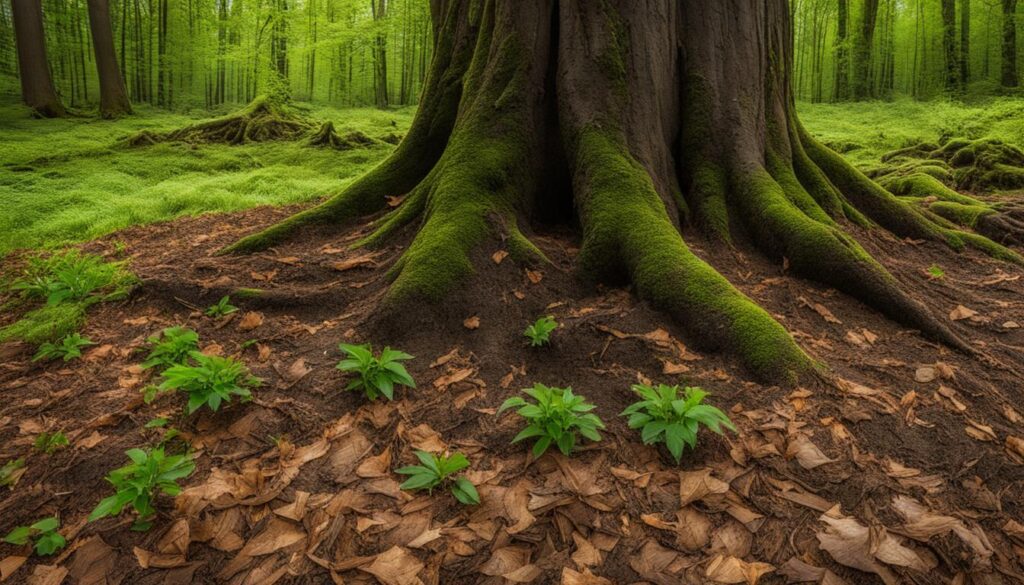

Considering The Proximity to the Previous Stump
I ask myself, “Can you plant a tree next to a stump?” The answer is not a straightforward yes or no. It’s crucial to measure the distance from the old stump before introducing a new tree to the garden. I follow guidelines suggesting that a tree should be planted at least six to eight feet away from any remaining tree stump. This distance helps prevent complications due to depleted soil nutrients and hinders root expansion potential. With these considerations, I ensure that my new tree is afforded fresh, unoccupied soil that is conducive to healthy growth.
Planting Near Old Tree’s Stump: Best Practices
Then, I strategize on planting a tree in a stump’s vicinity, securing the best start for my new arbor addition. Best practices for planting after stump grinding involve avoiding any unrecovered root zones to ensure my tree is not hindered by any underground remnants of its predecessor. I diligently rehabilitate the site with necessary soil amendments, focusing on providing a fertile foundation for the young sapling to flourish. Planting tree after stump grinding is more than just a task; it’s a commitment to the continued health and beauty of my landscape.
Preparing The Site for a New Tree
As I delve into the rejuvenation of a landscape following the removal of a tree, it’s important to highlight the preparatory steps for introducing a new woody resident to the garden. The process requires thoughtful consideration of the soil environment, as it forms the foundational support for the future growth and health of the planting. Embarking on soil enhancement for tree planting not only revitalizes the earth but also respects the legacy of its predecessor.
Enhancing Soil Quality for New Plantings
Starting with soil preparation for new trees, my goal is to adjust the nutrient profile to accommodate the specific needs of the new saplings. Amending soil after stump grinding often involves boosting the levels of organic matter–this can significantly improve the soil structure and its ability to retain moisture and nutrients.
Root Decomposition and Timing for Planting
Understanding when to plant after stump grinding is a question of balancing patience with eagerness. The timeline follows the natural process of root decomposition post-stump grinding, where remnants of the old tree’s roots gradually break down, creating space and resources for the incoming flora. I’ve learned that the predetermined waiting period can be an invaluable investment in the prosperity of new growth.
Removing Sawdust and Amending the Soil
After the grinding process, sawdust remains can be quite intrusive within the soil matrix. I’ve found that removing sawdust after stump grinding is beneficial in preventing the sawdust from sapping nitrogen—a nutrient crucial for the development of young plants. By adding suitable soil amendments for tree planting, such as compost or a balanced fertilizer, I am able to restore vitality to earth that seemed exhausted.
Picking The Right Tree Species for Replanting
I make it a point to match the tree species with the specific characteristics of the site. This involves replacing a tree that perhaps once stood tall with an apt successor, ensuring disease resistance in new trees, and ascertaining soil compatibility for new tree planting. The careful selection process can significantly bolster the longevity and success of the new specimen.
Disease Resistance and Compatibility with Existing Soil Conditions
It’s crucial to address concerns such as disease resistance when selecting new trees for a landscape that’s seen recent upheaval. Planting recommendations after stump grinding often circle back to choosing species that will not only resist former ailments but also harmoniously coexist with the site’s renewed soil chemistry.
Can You Plant a Tree Where One Was Removed?
Navigating questions like “can you plant a tree where one was removed,” or more precisely, “can you plant a new tree after stump grinding,” has led me to understand that success lies in a thorough evaluation of the site. The feasibility of planting a tree where one was removed is contingent upon the diligent reconditioning of the soil and surrounding landscape.
Step-by-Step Approach to Planting After Stump Removal
My tips for planting after stump grinding culminate in a step-by-step approach. This includes evaluating the prospective area, incorporating soil amendments, alleviating soil compaction, and choosing plant varieties wisely. Each step brings one closer to a regenerative and rewarding tree planting experience—be it planting shrubs after stump grinding or cultivating a tree in a stump’s footprint.
Stump Grinding and Landscape Planning Considerations
When integrating tree stump removal into landscape redesigns, comprehension of stump grinding mechanics and its implications for site preparation is fundamental. My focus here is to dispel some of the prevalent misconceptions surrounding stump grinding and share efficient strategies that aid in mitigating site disturbances through this process. These insights are designed to guide both homeowners and professionals in leveraging proper stump removal techniques for a streamlined transition to subsequent landscape planning phases.
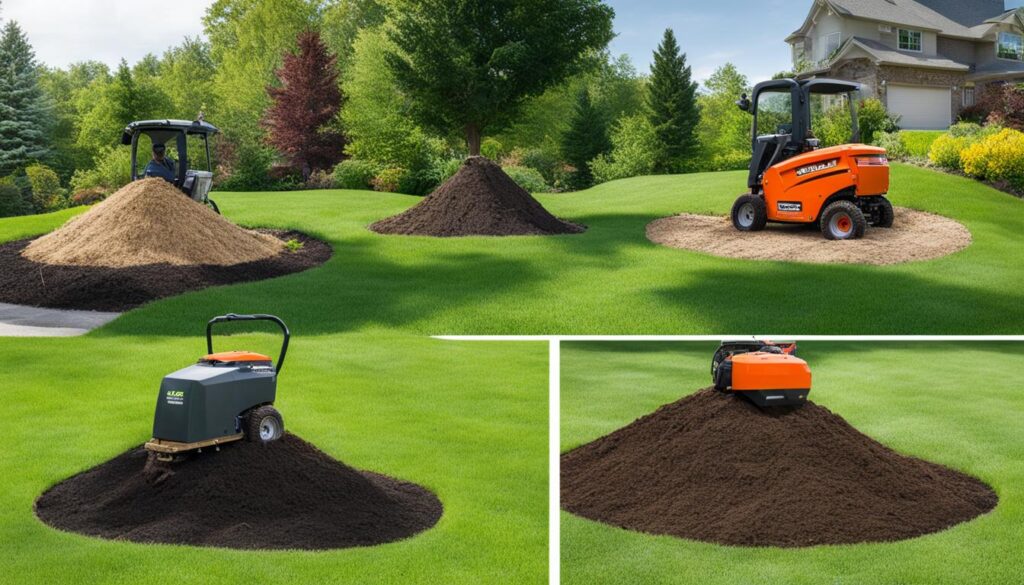

Avoiding Common Misunderstandings in Stump Grinding
It’s not uncommon for individuals to misinterpret the capabilities of stump grinding equipment. One major misconception I often encounter is the expectation that a stump grinder can produce fine mulch, akin to a mulcher, or neatly contained wood piles similar to a saw’s output. In reality, stump grinding and landscape planning operate in tandem; stump grinders are specifically designed to mechanically shred tree stumps below ground level, reducing them to chips and leaving a mixture of wood and soil. Clear communication with your chosen professional is essential to setting realistic expectations and achieving your desired results in soil prep and garden design.
Strategies for Minimizing Site Disturbance During Stump Removal
To maintain the integrity of your landscape during stump removal, selecting the right machinery and removal strategies is critical. I advocate for deploying the smallest possible grinder that is still effective for the task, thus minimizing its footprint on your property. Protective measures, such as positioning plywood to prevent soil compaction and careful planning to evade damaging nearby plants, are strategies I employ to protect the surrounding environment. Whether opting for grinding or implementing a tree spade depends on various factors such as accessibility, landscape design objectives, and the importance of preserving key landscape features. With these meticulous considerations and stump removal techniques, I’m committed to maintaining the harmony and aesthetics of your outdoor space, allowing for a seamless transition to landscape planning and design stages.
Post-Stump Grinding Planting Guidelines
After the strenuous task of stump grinding, I often face an array of debris that can be overwhelming. My primary concern is a prompt and thorough stump grinding debris assessment. The grindings, replete with nutrient-laden wood fibers, frequently are intermingled with soil and stones, none of which benefits the landscape if left unchecked. Understanding the indispensability of cleanup after stump grinding, I have learned that engaging professional services not only saves effort but ensures that the remnants don’t interfere with future gardening endeavours.
Assessing Stump Grinding Debris and Cleanup
One of the first steps I take post grinding is inspecting the site meticulously. Identifying materials and the volume of debris helps in figuring out if substantial soil amendment is necessary or a more straightforward cleanup after stump grinding will suffice. The sawdust and remaining fibers tend to be acidic and can adversely affect soil pH — a fact I bear in mind while preparing for new plantings.
Depth of Grinding and Its Impact on Planting Success
The depth of stump grinding is critical to the planting process that follows. When prepping for grass or introducing a new sapling into my garden, ensuring that the grinding goes at least six to eight inches below the soil surface is a must. This depth provides a clean slate for planting and is instrumental in avoiding any negative impact of grinding on planting. Deeper grinding might be a decision point if the plan includes construction or extensive landscape modification. The next steps, whether to backfill the hollow or let natural processes take over, hinge closely on the intentions I have for the area.
Conclusion
As we look back at the journey of transforming our gardens following stump grinding, it’s imperative to underscore the importance of adhering to a precise timeline for planting. My experience affirms that allowing a general waiting period of about a year facilitates significant soil recovery and root decomposition. During this interval, attending to any residual plant diseases is also crucial. This staging is not just about biding our time but about taking strategic steps to foster the ideal conditions for a new tree to prosper.
Summarizing the Timeline and Key Takeaways for Planting
In summarizing the tree planting timeline, my primary takeaway is the virtue of patience. Giving the landscape time to heal and amend itself after stump grinding ensures that planting success is not left to chance. Mitigating potential problems like soil nutrient imbalances and existing root obstruction are fundamental moves that can’t be rushed. This meticulousness solidifies the groundwork for the robust health and stability of the new addition to our green spaces.
Best Practices for Ensuring Planting Success Post Stump Grinding
If I could distill my advice on ensuring planting success after stump grinding into a kernel of wisdom, it would revolve around being conscientious with our choices and practices. Selecting a tree species that aligns with the current soil conditions, preemptively treating the soil, and locating the new plant strategically away from the old stump’s radius – these are non-negotiable best practices for tree planting success. Implementing these guidelines aids in circumventing future complications, laying the foundation for an environment where trees can not only grow but also thrive for years to come.
FAQ
How soon after stump grinding can you plant?
It’s recommended to wait about one year before planting a new tree in the exact location to allow for root decomposition and soil recovery. Soil amendments may be needed to rebalance nutrients if the ground contains a high volume of sawdust from the stump grinding.
Can you plant a tree where a stump was removed?
Yes, you can plant a tree where a stump was removed, but it is advisable to address any remaining roots, potential soil pathogens, and ensure that soil conditions are suitable for new growth before planting.
How close can you plant a tree to an old stump?
It’s best to plant the new tree at least six to eight feet away from the old stump to ensure the tree has access to adequate soil quality and space for root development.
What are the best practices for planting a tree near an old tree’s stump?
The best practices include assessing the soil quality, removing as much sawdust as possible, adding fresh topsoil or organic matter, avoiding large remaining roots, and choosing a tree species that is well-suited for the specific conditions of the planting site.
What effects does sawdust have on soil nutrient balance after stump grinding?
Sawdust can lower soil pH and tie up nitrogen, competing with new plantings for this essential nutrient. Therefore, it is important to remove or dilute sawdust in the soil and consider adding organic material to improve nutrient balance.
When can you plant shrubs after stump grinding?
For shrubs, you might not need to wait as long as for trees because their root systems are smaller. However, it’s still important to check soil conditions and remove or dilute sawdust to ensure the soil is ready for planting.
Can you plant a new tree immediately after stump removal?
It is not advised to plant a new tree immediately after stump removal because of potential soil quality issues and remaining root structures. It is better to wait, amend the soil as necessary, and ensure that the environment is conducive to the new tree’s growth.
How does root decomposition affect the timing for planting after stump grinding?
Root decomposition can take months to years, depending on the tree species and the environment. It’s crucial to allow sufficient time for roots to break down before planting a new tree to prevent competition for space and nutrients.
Are there any strategies to minimize site disturbance during stump removal?
Yes, using smaller stump grinding equipment when possible, protecting nearby plants, and laying plywood to prevent soil compaction can help minimize site disturbance during stump removal.
What is the proper depth for stump grinding if planning to plant another tree?
For planting grass or another tree, the stump should be ground to a depth of six to eight inches below the soil grade. For other projects like construction or extensive landscaping, deeper grinding may be necessary.
How important is it to clean up stump grinding debris?
Cleanup is essential as the grinding debris typically contains acidic wood fibers unsuitable for mulch and can affect soil pH and nutrient balance. It also prevents nitrogen depletion and ensures a clean site for new plantings.
Can you plant a tree in the same spot without removing the stump?
Planting a tree in the same spot without removing the stump is not recommended due to obstacles for root growth and challenges with soil quality. Removing the stump and preparing the soil are crucial steps before planting a new tree.
What should be considered when picking a species for replanting after stump removal?
When replanting, choose a tree species that is resistant to any diseases of the previous tree, suited to the existing soil conditions, and appropriate for the space and environment. It’s also important to consider the future size of the tree and its root system.

